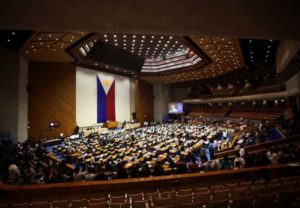
Joint session of Congress and Senate on the extension of Martial Law in Mindanao.
/INQUIRER PHOTO
ML EXTENSION IN MINDANAO
For the third time, Congress gave its nod on Wednesday to President Rodrigo Duterte’s request to extend martial law in Mindanao for another year, a move the Chief Executive said would “put an end to the on-going rebellion in Mindanao.”
And for the Cebu-based Armed Forces of the Philippines–Central Command (AFP-Centcom), the Visayas may even get some benefits from it in terms of securing the region’s peace and order situation.
Centcom Spokesperson Capt. Joe Patrick Martinez, said the extension of martial law in the island of Mindanao will bear no disadvantages to its neighbouring areas, such as Visayas.
“Ang kagandahan ng (the good thing about) martial law is, it gives law enforcers together with the AFP unit in Mindanao, the flexibility in implementing the security measures in all the islands of Mindanao that includes protecting the egress and ingress of the island,” said Martinez.
“’Yung effect or ‘yung declaration, mas naging safer ang mga tao in the whole island of Mindanao which includes the immediate vicinity particularly ‘yung adjacent islands, in this case the Visayas region,” he added.
Martinez further said that if the military in Mindanao island is protecting the egress and ingress of the island then it will also prevent lawless elements from transfering to other islands in the country.
“Ma-prevent din natin ang paglipat, pag-mobilize ng mga organizations or mga remnants na na engkwentro last year sa Lanao at Marawi City,” he added.
(We can prevent the transfer and mobilization of these organizations or remnants that we encountered last year in Lanano and Marawi City).
Congress’ votes
Twelve senators voted to extend martial rule in Mindanao until Dec. 31, 2019.
Five were against and one abstained.
On the part of the House, 223 voted to extend, 23 were against, with no abstentions.
With a final total vote of 235 for an extension, 28 against and one abstention, Congress voted to extend martial rule in the South.
The outcome came after about three hours of debates in a joint session at the Batasang Pambansa Complex in
Quezon City.
In his letter to Senate President Vicente Sotto III and House Speaker Gloria Arroyo dated December 6, Duterte said “rebellion still persists in Mindanao” and “public safety requires the continuation of martial law.”
The President said the extension of martial law would enable the Armed Forces of the Philippines, the Philippine National Police and other law enforcement agencies “to finally put an end to the on-going rebellion in Mindanao and continue to prevent the same from escalating in other parts of the country.”
Duterte first declared martial law in Mindanao on May 23, 2017, after the Islamic State-inspired Maute terrorist group attacked Marawi City.
He asked Congress to extend it until December of the same year.
The President later requested another extension until the end of 2018 despite the government’s declaration of an end to fierce urban fighting in the war-torn area.
Article VII Section 18 of the Constitution states that if there is “invasion or rebellion, when the public safety requires it,” the President may suspend the privilege of the writ of habeas corpus or place the Philippines or any part of it under martial law for not more than 60 days.
However, Congress, voting jointly, by a vote of at least a majority of all its members, may extend it upon the initiative of the President.
But if it were up to exiled Communist Party of the Philippines founder Jose Maria “Joma” Sison, President Duterte’s drive to place martial law nationwide is on track with the extension of military rule in Mindanao.